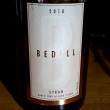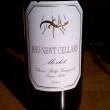What We Drank (6/16/09)
This week,we have four contributions to What We Drank, including the first from Sasha Smith. I wanted to mention something this week, badly, but there wasn't anything that I drank over the weekend that inspired me enough, sadly. More on that later this week I think.
 From Bryan Calandrelli: Freedom Run Winery Celebration Series Rosé
From Bryan Calandrelli: Freedom Run Winery Celebration Series Rosé
Working in the cellar at Freedom Run, I designed this wine specifically for my wedding favors. By that I mean blend, color and sweetness. The favor was a 375ml with a palm tree (we got married in Key West) and the wedding date. The blend, 93% Cayuga and 7% Cab Franc, with a residual sugar of 1.5%, turned out to be a big hit with everyone in Key West, so much so that I convinced the winery to bottle 100 cases of it and call it a dry rose.
Light and refreshing with aromas of strawberry and watermelon, this wine shows a delicate balance of acidity and sweetness. Luckily the Cayuga is quite neutral and makes a great base for the Cab Franc fruit to lead the way. While it\'s not the most complex rosé, nor will it satisfy the terroirists of the wine world, it can be a perfect addition to any summer meal.
 From Evan Dawson: Marc Hebrart NV French Champagne - Brut Rose
From Evan Dawson: Marc Hebrart NV French Champagne - Brut Rose
match for the tidal wave of Rose that is racing across the Finger
Lakes. In that spirit, I tried a brut rose — but wanted to see how a
French Champagne would fare. My wife opened this (rather expensive)
bottle this weekend. It's a one-note effort: Like drinking a
strawberry, it's fresh at first before eroding into a bit of Windex and
musty flavors.
Lakes sparkling rose. Heart & Hands already makes one, and I'd like
to know if others are doing the same. If we see more sparkling rose
locally, it will truly be a sign that Finger Lakes winemakers see the
world through rose-colored glasses.
From Melissa Dobson: Anthony Road Wine Company 2008 Martini-Reinhardt Select Vignoles TBA
Martini-Reinhardt Selection Grazing Gala at Anthony Road Wine Company. I had a difficult time choosing one of the featured
Martini-Reinhardt Selection wines as my weekend stand-out, but the 2008
M-RS Vignoles TBA edged out the pack because of the
scrumptious dessert pairing from Deb Whiting of Red Newt Bistro, who
prepared the food pairings for the gala. Deb presented the 2008 M-RS
Vignoles TBA with an orange curd mousse topped with candied orange peel
that was light and elegant, showcasing creamy bright citrusy heaven.
Winemaker
Johannes Reinhardt explained that the 2008 dessert wine grapes
encountered a "tough birth" but this traditional TBA was effected by
noble rot at over 50%, cool room stored, sorted for one week and
foot macerated. The result is a full-bodied, silky dessert wine with
citrus and apricot "showing its muscles" but playing well with the
orange curd mousse. This and the 2008 M-RS Riesling Trockenbeeren and
2008 M-RS Riesling Berry Selection dessert wines are not in bottle yet,
but will be within the next 2-3 months.
 From Sasha Smith: Flag Day Punch
From Sasha Smith: Flag Day Punch
In honor of Flag Day and our third anniversary, my husband and I
invited over 30 friends for a cookout. Because we're of the mind that
no party is complete without a signature drink, we came up with this
punch. Save for one ingredient, it's pretty low-rent…but it's also
pretty delicious.
This concoction is sure to please anyone who
appreciates a whiskey sour. Here's the recipe, such as it is: place
about 2 cups of frozen black currants, 6 cups of water and 1/2 to 3/4
cup of sugar in a saucepan and bring to a boil. (We used frozen
currants from this farm in Staatsburg, New York.) Lower to a simmer and cook
until the liquid reduces by more than half and becomes syrupy. (Around
an hour and a half.) Strain. Fill a 4-gallon jar with five limes,
thinly sliced. Add four cans of frozen pink lemonade from concentrate
as well as however much water it calls for on the canisters, minus a
cup or two. (You'll be adding ice to the jar and don't want the mixture
to get too diluted.) Pour in the black currant syrup and add several
trays of ice. Serve alongside a bottle of Jeremiah Weed bourbon
liqueur. That's right, bourbon liqueur. If you can't find any, Jack
Daniels will do, but there's something about the sweet, boozy kick of a
$16 bottle of Jeremiah Weed that hits the spot here. Not a drink to
serve to your boss, your in-laws, or anyone else you're trying to
impress, but a delightful beverage to enjoy among friends.














Evan, I’m not sure Hebrart has ever really been known for the rose. His standard white version is absolutely lovely.
As for Sasha! Well! I knew that someday I’d find out who the one person in the world was that drank Jeremiah Weed! Now we know…:)
Evan,
Your review of the Hebrart Rose’ has dampened my enthusiasm for drinking the two bottles we have down in our cellar! Morten made a rose’ methode champagnoise back in ’07 and we hope to release it next year. Sparking rose’ is a great wine for the Finger Lakes.
Evan: Dr. Konstantin Frank make a rose sparkler or two, don’t they?
Anyone else?
Lisa - Morgan insisted I add the following to my review of the Hebrart: It was strangely rocking on the second night! I know, bizarre. Still fresh strawberries, but this time there was a nutty creaminess (hints of oxidation maybe, Mr. Mansell?) that I really liked. And the glass cleaner taste was gone. So open it with enthusiasm!
That’s a relief…
Evan:
Nuttiness COULD be due to the presence of aldehydes (think the nuttiness of sherry). Toasty, bready compounds from yeast autolysis could also influence your perception of nuts.
I have observed some oxidation creeping into bottles after being open for only a day, even in the fridge. I have heard that champagne musts are particularly high in laccase, an oxidation enzyme, so oxidation is always a problem in Champagne winemaking. Depending on the sulfite addition during dosage, it could be prone to oxidation within a day or so. Then again, after a day or so, the champagne would be flat anyway (unless you have a fancy tool to seal in the CO2)…
Goose Watch on Cayuga Lake makes a sparkling pinot noir brut rose that’s nice. It picks up gold medals regularly.
Tom:
Great info on the chemistry. I’d also like to add that oxidation is also a problem in traditional Champagne winemaking because the still wine has to have low SO2 in order the second fermentation to move through successfully. So you’re looking at somewhere between 10-20ppm free SO2 to protect the wine and not interfere with the process of making beautiful bubbles. Some wineries have blends from 10 or more vintages, which means greater opportunities for oxidation to impact the final product.
Cheers!
Tom:
good point, the blending argument makes perfect sense to me.
but even if the still wine became a bit oxidized, wouldn’t the secondary fermentation create a reducing environment, such that oxidized stuff would un-oxidize? apparently oxidizing must was a common practice some years ago to reduce browning in the finished product.
oxidized must, after fermentation, usually comes out the same color and is more resistant to browning (Nagel and Graber, AJEV, 1998, http://www.ajevonline.org/cgi/content/abstract/39/1/1)
Tom -
Thanks for the info.
I’m not certain that an oxidized wine would then become reduced on the second fermentation. Also, I’m pretty certain that reduction is not going to correct an oxidized wine.
There are many contributing factors to reduction (H2S). One being lack of nutrients on the second fermentation. Oxygen can also help eliminate reduction during fermentation, but once fermentation is complete, you’ll need other tools to remove reduction.
I can’t speak on the browning/un-browning thing. I try to preserve the color as best I can and not put too much SO2 (total) - which can also lead to some browning/rust colored wine.
Cheers!